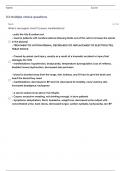Name: Score:
141 Multiple choice questions
Term 1 of 141
What is neurogenic shock? (causes, manifestations)
- pulls the h2o & sodium out
- Used in patients with cerebral edema (drawing fluids out of the cell to increase the solute
in the plasma)
- TREATMENT OF HYPONATREMIA, DECREASED ICP, REPLACEMENT OF ELECTROLYTES,
TREAT SHOCK
- Caused by spinal cord injury, usually as a result of a traumatic accident or injury that
damages the SNS
- manifestations: hypotension, bradycardia, temperature dysregulation, loss of reflexes,
bladder/ bowel dysfunction, decreased skin perfusion
- blood is shunted away from the lungs, skin, kidneys, and GI tract to give the brain and
heart the blood they need
- manifestations: decreased in BP and CO, decreased GI mobility, cool/ clammy skin,
increased deadspace, tachypnea
- A serum sodium level above 145 mEq/dL.
- Causes: excessive sweating, not drinking enough, in burn patients
- Symptoms: dehydration, thirst, headache, weight loss, decreased urine output with
concentrated urine, hard stools, decreased turgor, sunken eyeballs, tachycardia, low BP
,Term 2 of 141
What is the difference between sublethal and lethal wounds?
sublethal- does not cause cell death (atrophy, hypertrophy)
lethal- causes cell death (hypoxia, radiation, mechanical trauma, chemical)
- A serum potassium level that exceeds 5.5 mEq/L.
- Causes: decreased insulin, DKA
- Symptoms: muscle weakness, paralysis
- INCREASED T-WAVE AND HYPERACTIVE PERISTALSIS
- Begins when compensatory mechanisms fail
- manifestations: pulmonary edema, bronchoconstriction, hypotension, ischemia, jaundice,
decreased urinary output, anasarca
- blood is shunted away from the lungs, skin, kidneys, and GI tract to give the brain and
heart the blood they need
- manifestations: decreased in BP and CO, decreased GI mobility, cool/ clammy skin,
increased deadspace, tachypnea
Term 3 of 141
What are the steps in sepsis development? (4)
tachypnea, tachycardia, altered LOC, decreased urine output, increased creatinine,
hypoactive bowel sounds, hyperglycemia, cool/ clammy skin, hypotension
Causes (surgical/ non-surgical, acute/ chronic), level of contamination, depth of the
affected tissue, color
In the early stage of septic shock, the patient has warm and dry skin. Cool and clammy skin
would indicate that the shock is progressing.
1. The antigen enters the body
2. the inflammatory response is triggered
3. there is an exaggerated response
4. endothelial injury occurs= vasodilation
,Term 4 of 141
What body organs fail first in progressive shock?
LACTATE (will be >0.2)
Liver, GI, & kidneys
hypoxemia.
tissue oxygenation
Term 5 of 141
What are the sepsis diagnostics?
- a controlled increase in body temperature (fever, also shivering)
++ lactate, increased CRP/ WBC
for tissue repair
apoptosis, necrosis, gangrene
Term 6 of 141
What is the SIRS assessment/ criteria for?
- Sepsis is a complication of an infection
- septic shock is a severe condition that occurs when the body's blood pressure falls and
organs shut down
1. injury occurs
2. platelet plug formation
3. fibrin clot development
4. clot retraction/ dissolution
In the early stage of septic shock, the patient has warm and dry skin. Cool and clammy skin
would indicate that the shock is progressing.
SIRS criteria are used as a screening tool to identify patients that may need further workup
for sepsis and severe sepsis.
, Term 7 of 141
What is calcium? (purpose)
minor allergic reaction (rash, hives, runny nose)
- A serum calcium level that exceeds 2.6 mg/dL.
- N/V, coma, fatigue
- A serum magnesium level les than 0.7 mg/dL.
- weakness, irritability, delirium, seizure
for muscle contractility, heart conduction, blood clotting
Term 8 of 141
What occurs to the blood vessels in anaphylaxis?
vascular response, cell response
Used to keep MAP >65
massive vasodilation
Angioneurotic edema.
Term 9 of 141
What is the purpose of magnesium?
SIRS criteria are used as a screening tool to identify patients that may need further workup
for sepsis and severe sepsis.
for metabolic processes
- Primary ECF anion
- provides electroneutrality
Angioneurotic edema.




